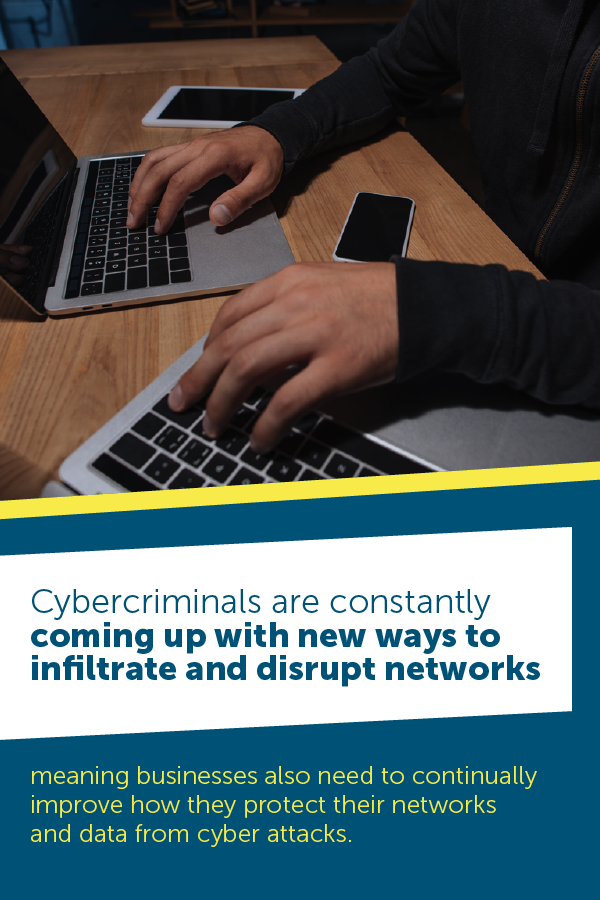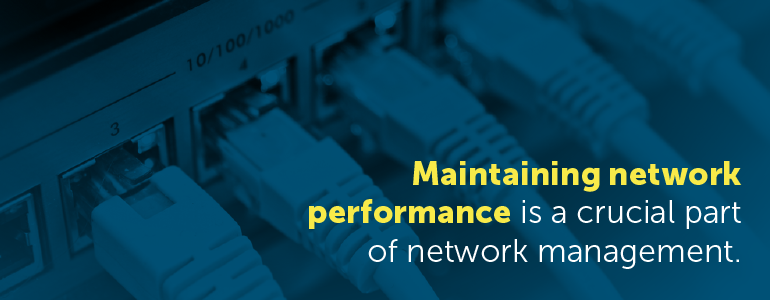
Top Challenges with Network Management
Network management encompasses many different areas including performance management, fault identification, network provisioning and maintaining the quality of service. As the size and complexity of networks grow through the introduction of new technologies, network managers are facing new challenges. Today, networks must be able to handle more traffic moving in more directions from more devices. While each new connection provides added capabilities, they also create new potential vulnerabilities that network professionals need to manage. The size and complexity of network management have led many companies to outsource their management to experienced third parties.
Here are some of the top challenges of IT managers in network management today across the following four categories: network security, configuration management, cost and network performance.
1. Network Security
Maintaining network security requires constant vigilance and the ability to respond to always-evolving threats. Today, the perimeter of the network is increasingly unclear, making it harder to protect against threats. Blocking unauthorized outside traffic is not enough to protect data, as threats can enter the network through phishing emails and insider attacks.
Service attacks don’t even have to successfully connect to succeed, and while encryption helps to protect data, it also makes it more difficult to monitor activity on the IT network. Many firms use numerous data protection tools and must ensure they work together for maximum effectiveness. Using multiple tools in this way requires increased management and monitoring.
Data Breaches on the Rise
Data breaches are a significant threat to today’s businesses. The costs of data breaches are increasing, according to the 2018 Cost of a Data Breach Study from the Ponemon Institute. According to the study, the average cost of a data breach worldwide is $3.86 million, an increase of 6.4 percent from 2017. The global average cost of each stolen record that contains sensitive and confidential information increased by 4.8 percent from 2017 to $148 per record.
The report also found that breaches are getting larger. The average size of a data breach among the companies surveyed increased by 2.2 percent from 2017 to 2018.
More Users, Devices and IP-Based Systems
The growing number of users and devices on each network is making managing security more challenging. In addition to employees, security teams have to contend with unmanaged users such as business partners. Employees are also using more mobile devices, both managed and unmanaged. As virtualized software becomes more common, more employees are using their personal devices for work — a trend called bring your own device (BYOD). Protecting unmanaged devices creates new challenges, as the company does not control every aspect of these devices.
The growth of internet protocol (IP)-based applications and systems — such as voice over internet protocol (VoIP), virtual desktop infrastructure and IP-based storage — also means that security teams have more endpoints and access points to monitor. As the network expands and becomes more complex, it becomes increasingly difficult to monitor traffic.

Constantly Evolving Threats
Cybercriminals are constantly coming up with new ways to infiltrate and disrupt networks, meaning businesses also need to continually improve how they protect their networks and data from cyber attacks. Because of this ever-changing threat landscape, cybersecurity requires constant attention and resources. Network managers need to stay up to date on the latest cybersecurity incidents, technologies and trends so that they can keep their networks safe.
To keep up with security threats, it’s crucial that companies conduct penetration testing to determine where their security weaknesses are. Modern businesses also need to embrace advanced security tools that incorporate artificial intelligence, automation and other technologies and keep those tools updated.
Regulations
The changing regulatory landscape also presents challenges. Companies must keep up with changes in regulations and ensure compliance with state and national laws, industry standards and international regulations. Healthcare companies must maintain compliance with HIPAA alongside many other regulations. Recently, many companies had to adjust to the introduction of the European Union’s General Data Protection Regulation (GDPR), and some states are introducing their own, similar laws. Ensuring compliance with the various applicable regulations can be complex and expensive, but it’s necessary for successful network management and security. Proper network management can help ensure compliance with regulations.
2. Configuration Management
Another challenging area of IT network management is configuration management, which involves gathering and maintaining information about all of the components within a computer network. This information includes the network address or IP address of every hardware device and information about default settings and which programs are installed on network devices.
Whenever the network requires repair, expansion, upgrading or modification, you can refer to the configuration management database to help you determine how to go about making the change. Activities involved in network configuration management include device discovery, IT network inventory management, configuration database backup, monitoring changes, ensuring compliance, tracking user activity and troubleshooting.
Expanding Networks and More Devices
Like with security, a major challenge that affects configuration management is the increasing size of the typical network. As the number of devices on each network grows, it becomes hard to keep all information and settings up to date, and devices can sometimes conflict with one another.

One reason for the growing number of devices is the Internet of Things (IoT), which refers to the vast array of devices, from smart thermostats to industrial machines to wearables, that can now connect to the internet and communicate with each other. In 2018, there was already an estimated 10 billion IoT devices, and Business Insider Intelligence forecasts that number will rise to 64 billion IoT devices by 2025.
Beyond the challenge of the sheer volume of devices, the advent of IoT technology means network configuration managers now need to track a much wider variety of device types and keep them up to date, functional and secure.
BYOD is another segment that is expected to grow rapidly. Global Market Insights, Inc. forecasts that the BYOD market size will reach an estimated $366.95 billion by 2022, an increase from $30 billion in 2014. Between 2015 and 2022, the market is expected to grow at a compound annual growth rate (CAGR) of more than 15% from 2015 to 2022.
Network configuration managers have to figure out how to keep track of BYOD devices and integrate them into their management system. Employees may bring a wide range of devices into work, and the company can’t manage every aspect of these devices. Accounting for each device is still crucial, however, for network configuration management and security.
Despite these challenges, it’s essential that firms prioritize configuration management. Problems with network configuration hurt network performance, result in non-compliance with regulatory standards and compromise network security.
3. Cost and Available Budget
As more business functions move onto the network, companies need to upgrade their networks to add capacity and new capabilities. In addition to traditional IT applications, networks now need to handle other business services, like telephony and video conferencing, which require improved network bandwidth. Multimedia applications also require the addition of multicasting protocols, new endpoint devices require autoconfiguration protocols and adding new services to shared network infrastructure requires the introduction of IP virtualization features.
Adding these capabilities to the network, however, is expensive and often time-consuming. You may need to:
- Introduce new hardware to increase bandwidth
- Deploy new software releases onto existing hardware
- Update configuration on existing infrastructure to enable new protocols
- Upgrade cabling to higher-spec cable types
- Hire experts to help with setting up and managing network features
Even as more demand is placed on IT, there is a push to reduce the cost of ownership of network infrastructure. This means IT staff need to figure out how to improve the network and add capabilities without significantly increasing costs — or sometimes even while cutting costs.
Companies can’t afford to sacrifice proper network management to reduce costs, as it’s crucial to business success. The cost of downtime, data leaks and other issues can easily result in much higher costs than those of upgrading and maintaining the network. Limited budgets can make it difficult to maintain network security. In a survey of around 400 IT decision makers in the United States and the United Kingdom conducted by Spiceworks for BAE Systems, 50 percent of respondents said that budget is a top barrier to network security.
To help reduce costs, many businesses are turning to third-party network management providers. The complexity of today’s networks means many businesses are spending a significant amount of time and resources on network management, leaving less for their core business activities. Working with an experienced third party that provides network management services can help businesses save money and time and put more focus on their core activities. It’s also important to highlight that investments in IT can drive revenue and improved performance for the company, rather than focusing on the costs of IT.

4. Network Performance
Maintaining network performance is a crucial part of network management. Today, businesses rely on their networks for more than ever before, and an outage can mean significant losses.
A recent survey of more than 1000 businesses worldwide by Information Technology Intelligence Consulting (ITIC) found that one hour of downtimes costs 98% of companies at least $100,000. Around 86% of surveyed companies said that one hour of downtime costs $300,000, while 81 percent said it costs more than $300,000. About one in three respondents even said that a single hour of downtime can cost more than $1 million. These numbers don’t include fines or civil or criminal penalties or the costs of any litigation that could result from lawsuits or non-compliance issues caused by the downtime.
Clearly, ensuring reliable network performance is crucial for business success. However, as networks expand and become more complex, doing so is increasingly challenging.
More Traffic and More Complexity
Modern businesses rely on their networks for a huge range of activities, many of which are mission-critical. They’re crucial for everything from internal communications to e-commerce sites to marketing campaigns. There’s more activity, and much of this activity — such as video conferencing — demands significant bandwidth from the network. Many businesses, especially online-based ones, also need their network to available and reliable 24/7.
Today, networks need to be able to handle more traffic from more directions. With more traffic on the network and longer distances between users and services, there is higher risk of poor network performance. Businesses need to have the right equipment and the right network management processes in place to ensure consistently high levels of reliability.
Ensuring adequate network performance requires careful management of bandwidth, latency and packet loss because problems can occur if they drop even slightly below tolerance thresholds. Those managing the network need to be able to constantly monitor network performance in real-time and have the visibility to determine how much bandwidth a given application is using and the associated IP addresses. They also need to be able to efficiently troubleshoot and assess whether the network is ready for new services before they’re deployed.
Time Spent Troubleshooting
Business’ networks play a crucial role in strategic business initiatives, but network professionals often struggle to find the time to work on these initiatives because they need to spend so much time troubleshooting issues across the network. As networks become larger and more complex, troubleshooting becomes more time-consuming — especially if there are limited amounts of visibility and control.
To ensure network professionals have time to work on businesses initiatives in addition to troubleshooting, businesses can improve their IT network management tools, increase IT resources and personnel or work with a third party on certain aspects of their network management.
Healthcare Network Management Solutions From Prelude Services
Today’s businesses face a range of network management challenges related to security, configuration management, costs and performance. As you navigate the quickly shifting business and tech environments, remember that Prelude Services is here to help. We provide network management, security IT strategic planning and around-the-clock support to healthcare companies across the U.S. Some of the IT network management services and solutions we provide include:
- Management tools that track usage trends across your network and alert our team when it needs an upgrade to maintain peak performance and security
- Design tools that help in planning upgrades and expansions to enable your network to grow with your company and introduce new capabilities
- Internet monitoring tools that prevent malicious software from entering your network from online sources, preventing potential damage to your business and saving your network managers time and resources
- Security tools that detect any malicious software on your network and alert our managers, so we can quickly address the issue and prevent damage
- Network backup and failover capabilities to ensure you don’t lose data in the event of a disaster, protecting your business and your data subjects
IT Network Mangement Services
We help hundreds of senior living, long-term care, skilled nursing, community service, affordable housing and other healthcare organization locations, throughout the country, set up their IT networks, protect their electronic health records and ensure HIPAA compliance. We take pride in supporting our clients so that they can better serve their communities. To learn more about how our networking software and services could benefit your organization, contact us today.
CONTACT PRELUDE SERVICES FOR 24/7 IT SUPPORT
Technology has become a crucial part of the modern business experience. Without functional computers and mobile phones, many business practices would grind to a halt. Unfortunately, breakdowns and malfunctions are an inevitable part of any machine, meaning businesses do grind to a halt until the issues are fixed. In order to keep your business running, it's crucial to have access to IT support when you experience technical difficulties.
If you're a healthcare company, long-term care provider, or small business in need of IT support at all hours, consider Prelude Services. We're a SSAE SOC
Compliant business dedicated to improving your security and functionality. We offer specific IT services for senior living care, nursing homes, retirement home services and assisted living, including 24/7 IT support. If you want to know how Prelude can help you, contact us today!

